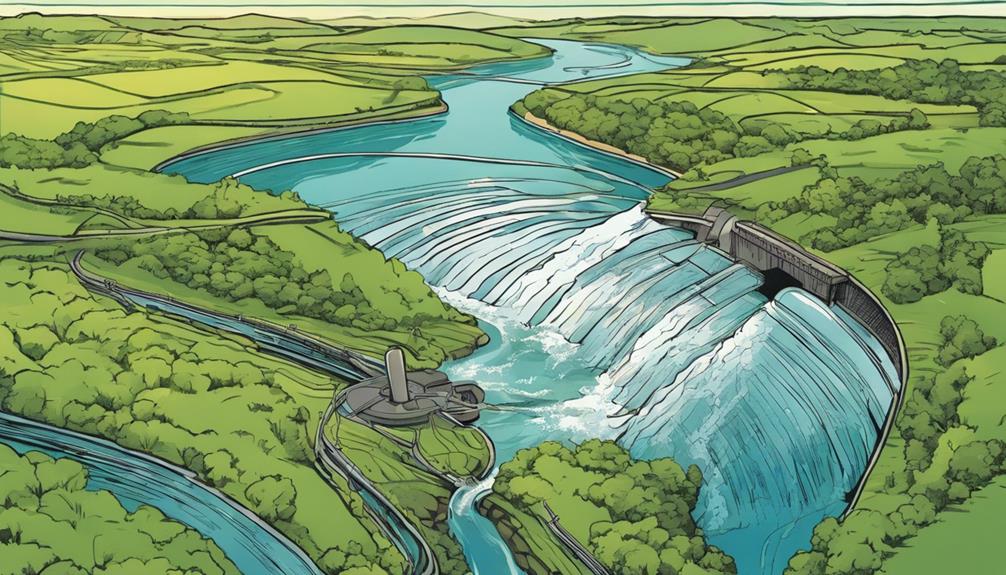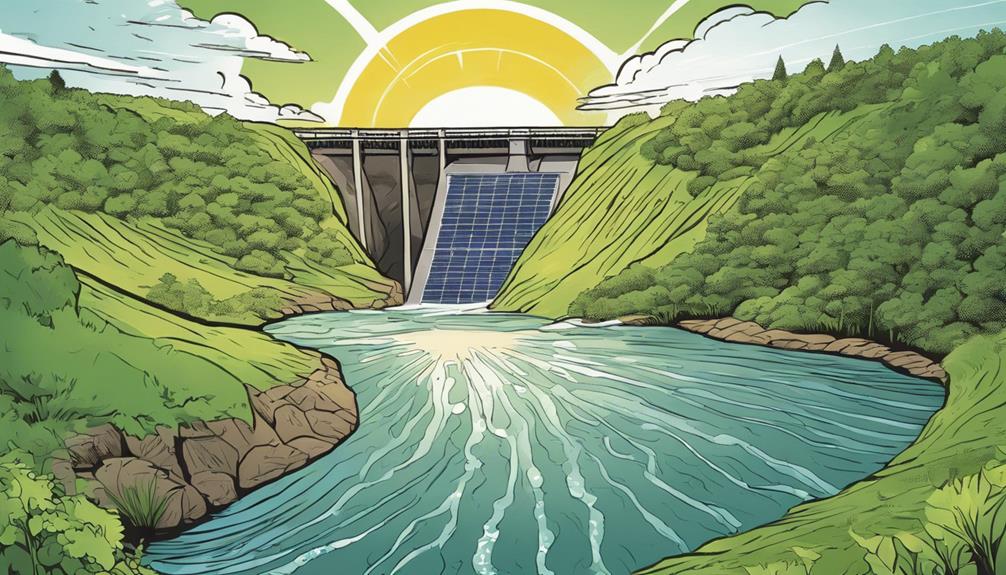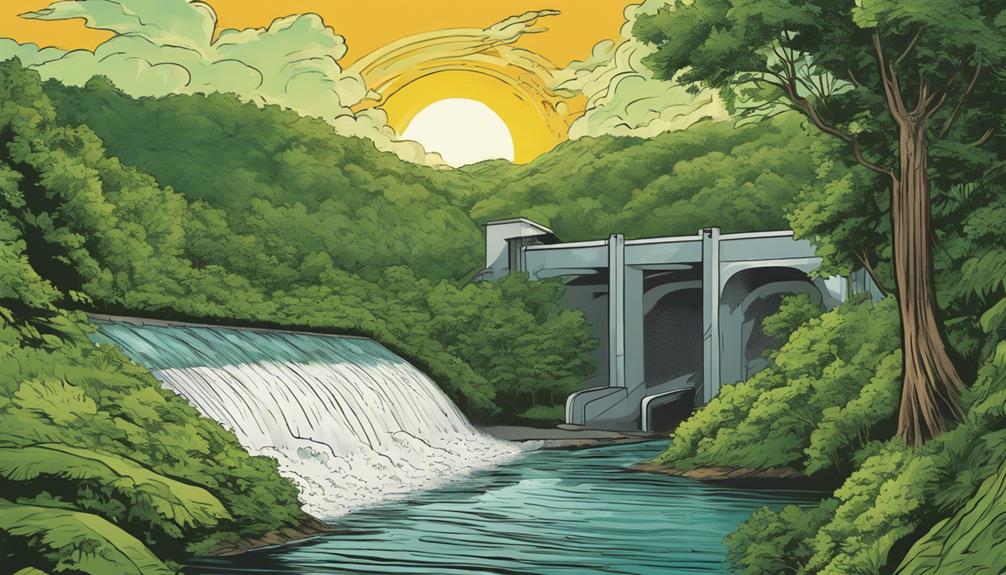We've always known that hydroelectric power comes from the energy of flowing water, but what's often overlooked is that this energy is indirectly harnessed from the sun's heat. The sun drives the water cycle, evaporating water and replenishing our resources. In turn, we harness this energy by creating reservoirs and releasing water through turbines, generating electricity. But there's more to this connection than meets the eye. As we explore the intricate relationship between the sun, water, and hydroelectric power, we'll uncover the hidden dynamics that make this sustainable energy source possible.
Key Takeaways
- The sun's heat drives the water cycle, influencing hydroelectric power by evaporating water and replenishing water resources.
- Hydroelectric power relies indirectly on the sun's heat, as it powers the water cycle that fuels hydroelectricity.
- The gravitational potential energy of water is influenced by the sun's heat, affecting the efficiency of hydroelectric power generation.
- Advances in solar energy technology can boost the efficiency of hydroelectric power plants, leading to more electricity generation.
- Understanding the connection between solar energy and hydroelectric power is vital for creating sustainable and clean electricity generation solutions.
Hydroelectric Power Basics

We generate hydroelectric power by harnessing the energy of flowing water, a process that relies on an important component: dams. These structures create reservoirs that allow us to control the flow of water and generate electricity on demand.
When we release water from the reservoir, it flows through turbines connected to generators. The turbines convert the kinetic energy of the water into mechanical energy, which is then transformed into electrical energy by the generators.
This clean and sustainable electricity can power homes, businesses, and industries. By leveraging the energy of flowing water, we're able to produce a significant portion of the world's electricity, making hydroelectric power a crucial part of our global energy mix.
Solar Energy Essentials

As hydroelectric power relies on the energy of flowing water, it's fascinating to explore the underlying driver of this process – the sun's energy, which powers the water cycle and, in turn, enables hydroelectric power generation.
We're talking about solar energy, a renewable and clean source of power. We harness it to generate electricity, heat water, and even power vehicles. The best part? Solar energy reduces greenhouse gas emissions, mitigating climate change. It's also cost-effective, requiring minimal maintenance and offering long-term savings. Plus, it promotes energy independence, especially in remote areas.
The Solar Connection

The sun's heat drives the water cycle, powering hydroelectricity through its subtle yet profound influence on our planet's hydrology.
We often overlook this connection, but understanding that hydroelectric power relies on solar energy is vital. The sun's heat evaporates water, which eventually becomes precipitation, and this process is the backbone of hydroelectric power generation.
We harness the energy of flowing water, which is ultimately driven by the sun's heat, to generate electricity. This indirect yet critical link between solar energy and hydroelectric power makes hydroelectricity a clean and sustainable source of energy.
Harnessing Water Energy

Now that we've delved into the solar connection, let's tap into the kinetic energy of flowing water.
We're discussing harnessing water energy, a pivotal aspect of hydroelectric power. As it's common knowledge, dams play an essential role in creating controlled water reservoirs.
When water is released from these reservoirs, it flows through turbines, converting its kinetic energy into mechanical energy. This mechanical energy is then transformed into electrical energy, powering our homes, industries, and daily lives.
The effectiveness of this process relies on the gravitational potential energy of water, which is ultimately influenced by the sun's heat. By harnessing water energy, we're indirectly tapping into the sun's power, making hydroelectric power a clean and sustainable source of electricity.
Clean Electricity Generation

We're generating clean electricity through hydroelectric power plants, where solar-powered water turbines efficiently convert the kinetic energy of flowing water into electrical energy.
This process is made possible by the sun's heat, which drives the water cycle and replenishes our water resources.
As the water flows through the turbines, its kinetic energy is harnessed and transformed into mechanical energy, which is then converted into electrical energy by generators.
The result is a reliable and sustainable source of clean electricity, free from greenhouse gas emissions and other pollutants.
Hydroelectric Power Efficiency

Advances in solar energy conversion technology have greatly boosted the efficiency of hydroelectric power plants, enabling us to harness more electricity from the same amount of flowing water.
As we've seen, hydroelectric power is an indirect form of solar energy, relying on the sun's heat to drive the water cycle. By leveraging these advancements, we can optimize the performance of our hydroelectric power plants.
This means we can generate more clean electricity while minimizing our environmental footprint. With improved efficiency, we can also reduce the cost of electricity production, making hydroelectric power an even more attractive option for countries seeking sustainable energy solutions.
Sustainable Energy Future

As we move towards a sustainable energy future, harnessing the connection between solar energy and hydroelectric power becomes increasingly important in reducing our reliance on fossil fuels and mitigating climate change.
We can leverage the sun's energy to drive the water cycle, which in turn powers hydroelectric plants. This indirect yet vital link enables us to generate clean and sustainable electricity.
By investing in solar-powered water turbines and hydroelectric infrastructure, we can significantly reduce our carbon footprint. As we continue to innovate and improve efficiency, we're poised to unveil the full potential of this renewable energy duo.
Together, let's create a greener, more sustainable future powered by the sun's hidden energy connection.
Frequently Asked Questions
How Does Hydroelectric Power Balance Energy Supply and Demand?
'We manage energy supply and demand by regulating water flow through dams, storing excess energy for peak periods, and optimizing turbine efficiency to guarantee a stable and reliable electricity supply.'
Can Hydroelectric Power Plants Be Built in Urban Areas?
We can build hydroelectric power plants in urban areas, but it's challenging due to limited water resources and space constraints. However, innovative designs and micro-hydroelectric systems can make urban hydroelectric power a viable option
What Is the Average Lifespan of a Hydroelectric Power Plant?
We're curious about the average lifespan of a hydroelectric power plant. Typically, it ranges from 50 to 100 years, depending on factors like maintenance, upgrades, and environmental conditions.
How Does Hydroelectric Power Compare to Wind Power in Terms of Cost?
"We weigh wonders, and wind power wins on whimsical whims, with lower startup costs, but hydroelectric power's long lifespan and scalability sway us towards its sustainable splendor."
Can Hydroelectric Power Be Used for Industrial Applications?
We think hydroelectric power can definitely be used for industrial applications, as its clean and sustainable electricity can efficiently power machinery and equipment, reducing energy costs and environmental impact.
How Does Catalyst Power Relate to Hydroelectric Power and the Sun’s Energy Connection?
The relationship between catalyst power, hydroelectric power, and the sun’s energy connection lies in the process of unlocking energy pathways revealed. Catalysts facilitate chemical reactions in hydroelectric power generation, while the sun’s energy is harnessed through photovoltaic cells, both of which involve unlocking energy pathways revealed to produce electricity.
Which is More Efficient for Generating Power: Solar or Hydroelectric?
In the ongoing debate of the solar vs. hydroelectric showdown, both energy sources have their advantages. Solar power is more flexible and can be deployed in a variety of locations, while hydroelectric power is more consistent and reliable. Ultimately, the most efficient option depends on the specific environmental and logistical factors at play.
What is the relationship between solar energy and hydroelectric power?
Solar energy power unleashed through photovoltaic cells captures sunlight to generate electricity. In contrast, hydroelectric power is harnessed from flowing water, such as rivers or waterfalls. While they both produce renewable energy, solar energy is dependent on sunlight, whereas hydroelectric power relies on water sources for generation.
What is the connection between solar power and hydroelectric power in terms of energy production?
The solar power dominance battle and hydroelectric power are connected through their energy production methods. Both use renewable sources to generate electricity, with solar power harnessing the sun’s energy and hydroelectric power using the force of flowing water. These complementary sources contribute to a more diversified and sustainable energy mix.
Conclusion
As we stand at the cusp of a renewable energy revolution, we're reminded that the ancient Greeks were onto something when they worshipped Helios, the sun god.
Today, we're harnessing his power in ways both direct and indirect. By recognizing the symbiotic relationship between hydroelectric power and solar energy, we're revealing the secrets to a sustainable future.
As we forge ahead, let's not forget that the sun's hidden energy connection is the key to a brighter, cleaner tomorrow – one that's been burning bright since the dawn of time.










